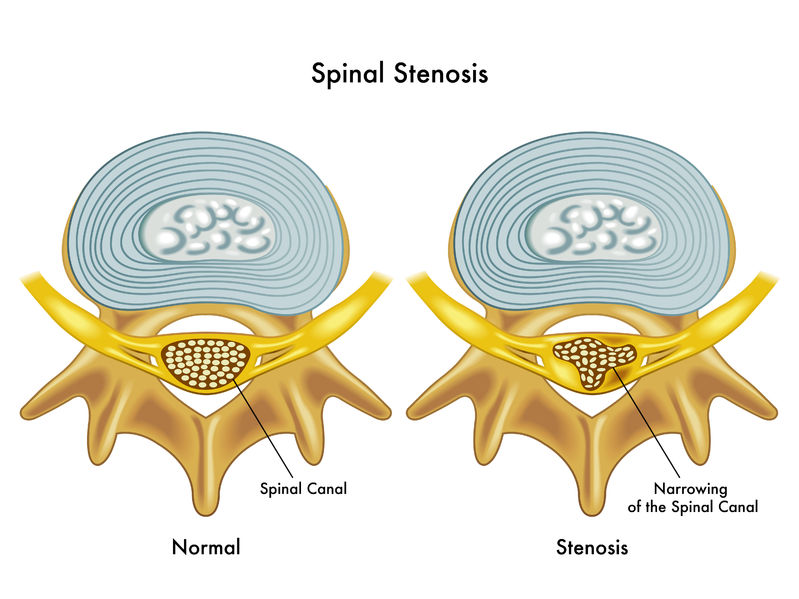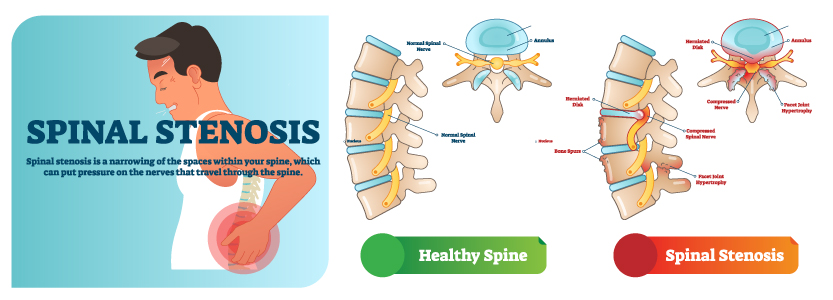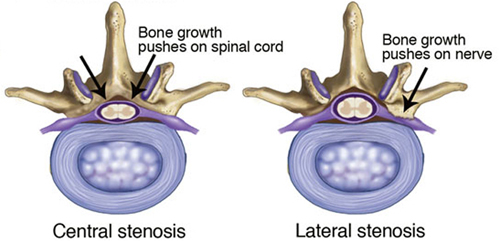Spinal stenosis is a narrowing of the spaces within your spine, which can put pressure on the nerves that travel through the spine. Spinal stenosis occurs most often in the lower back and the neck. Some people with spinal stenosis may not have symptoms. Others may experience pain, tingling, numbness and muscle weakness. Symptoms can worsen over time.
Spinal stenosis is most commonly caused by wear-and-tear changes in the spine related to osteoarthritis. In severe cases of spinal stenosis, doctors may recommend surgery to create additional space for the spinal cord or nerves.

Types of spinal stenosis
The types of spinal stenosis are classified according to where on the spine the condition occurs. It’s possible to have more than one type. The two main types of spinal stenosis are:
- Cervical stenosis. In this condition, the narrowing occurs in the part of the spine in your neck.
- Lumbar stenosis. In this condition, the narrowing occurs in the part of the spine in your lower back. It’s the most common form of spinal stenosis.
OPENING HOURS
| Week Days | 8:00 – 5:00 |
| Saturday | 9:00 – 5:00 |
| Sunday | 11:00 – 4:00 |
(254) 20 440 1349 (254) 791 399 103/4 (254) 780 888 823
OFFICE LOCATION
OUR VALUES
sint occaecati cupiditate non provident, similique sunt in
sint occaecati cupiditate non provident, similique sunt in
sint occaecati cupiditate non provident, similique sunt in
Symptoms

Many people have evidence of spinal stenosis on an MRI or CT scan but may not have symptoms. When they do occur, they often start gradually and worsen over time. Symptoms vary depending on the location of the stenosis and which nerves are affected.
In the neck (cervical spine)
- Numbness or tingling in a hand, arm, foot or leg
- Weakness in a hand, arm, foot or leg
- Problems with walking and balance
- Neck pain
- In severe cases, bowel or bladder dysfunction (urinary urgency and incontinence)
In the lower back (lumbar spine)
- Numbness or tingling in a foot or leg
- Weakness in a foot or leg
- Pain or cramping in one or both legs when you stand for long periods of time or when you walk, which usually eases when you bend forward or sit
- Back pain
Causes
The backbone (spine) runs from your neck to your lower back. The bones of your spine form a spinal canal, which protects your spinal cord (nerves). Some people are born with a small spinal canal. But most spinal stenosis occurs when something happens to narrow the open space within the spine. Causes of spinal stenosis may include:
- Overgrowth of bone. Wear and tear damage from osteoarthritis on your spinal bones can prompt the formation of bone spurs, which can grow into the spinal canal. Paget’s disease, a bone disease that usually affects adults, also can cause bone overgrowth in the spine.
- Herniated disks. The soft cushions that act as shock absorbers between your vertebrae tend to dry out with age. Cracks in a disk’s exterior may allow some of the soft inner material to escape and press on the spinal cord or nerves.
- Thickened ligaments. The tough cords that help hold the bones of your spine together can become stiff and thickened over time. These thickened ligaments can bulge into the spinal canal.
- Tumors. Abnormal growths can form inside the spinal cord, within the membranes that cover the spinal cord or in the space between the spinal cord and vertebrae. These are uncommon and identifiable on spine imaging with an MRI or CT.
- Spinal injuries. Car accidents and other trauma can cause dislocations or fractures of one or more vertebrae. Displaced bone from a spinal fracture may damage the contents of the spinal canal. Swelling of nearby tissue immediately after back surgery also can put pressure on the spinal cord or nerves.
Risk factors
Most people with spinal stenosis are over the age of 50. Though degenerative changes can cause spinal stenosis in younger people, other causes need to be considered. These include trauma, congenital spinal deformity such as scoliosis, and a genetic disease affecting bone and muscle development throughout the body. Spinal imaging can differentiate these causes.
Complications
Rarely, untreated severe spinal stenosis may progress and cause permanent:
- Numbness
- Weakness
- Balance problems
- Incontinence
- Paralysis
OPENING HOURS
| Week Days | 8:00 – 5:00 |
| Saturday | 9:00 – 5:00 |
| Sunday | 11:00 – 4:00 |
(254) 20 440 1349 (254) 791 399 103/4 (254) 780 888 823
OFFICE LOCATION
OUR VALUES
sint occaecati cupiditate non provident, similique sunt in
sint occaecati cupiditate non provident, similique sunt in
sint occaecati cupiditate non provident, similique sunt in

How is spinal stenosis diagnosed?
If you have symptoms of spinal stenosis, your doctor will start by taking a medical history, performing a physical exam, and observing your movements.
Your doctor may also order tests to check for signs of stenosis, such as:
- X-ray, MRI scan, or CT scan to view images of your spine
- electromyogram to check the health of spinal nerves
- bone scan to look for damage or growths in your spine
What are the treatment options for spinal stenosis?
First-line treatments
To treat spinal stenosis, your doctor will likely start by prescribing medication.
Cortisone injections into your spinal column can reduce swelling. Nonsteroidal anti-inflammatory drugs (NSAIDs) can help ease pain.
Your doctor may also recommend physical therapy to help strengthen and stretch your muscles.
Surgery
If you have severe pain or weakness, your doctor may recommend surgery to treat spinal stenosis.
They may also prescribe surgery if the condition is affecting your ability to walk, control your bowel or bladder, or do other routine activities.
Several types of surgery are used to treat spinal stenosis:
- Laminectomy is the most common type of surgery. A surgeon removes part of the vertebrae to provide more room for the nerves.
- Foraminotomy is used to widen the part of the spine where the nerves exit.
- Spinal fusion is typically performed in more severe cases, especially when multiple levels of the spine are involved. Bone grafts or metal implants are used to attach the affected bones of the spine together
OPENING HOURS
| Week Days | 8:00 – 5:00 |
| Saturday | 9:00 – 5:00 |
| Sunday | 11:00 – 4:00 |
(254) 20 440 1349 (254) 791 399 103/4 (254) 780 888 823
OFFICE LOCATION
OUR VALUES
sint occaecati cupiditate non provident, similique sunt in
sint occaecati cupiditate non provident, similique sunt in
sint occaecati cupiditate non provident, similique sunt in
